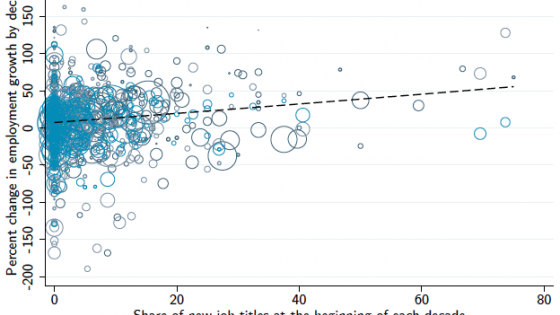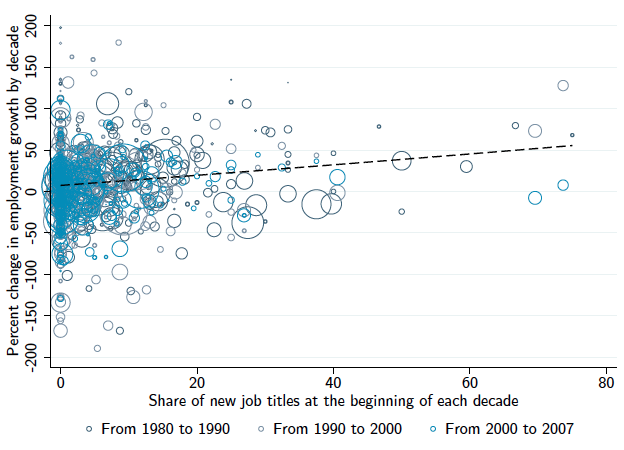Concerns that new digital technologies, artificial intelligence, and robotics will create widespread technological non-employment are now widespread. Various recent labour market trends, ranging from declines in US labour force participation to increases in wage inequality and the share of capital in national income, are seen as harbingers of this new normal (e.g. Brynjolfsson and McAfee 2012, Akst 2014, Autor 2015, Karabarbounis and Neiman 2014, Oberfield and Raval 2014). A major shortcoming of the typical arguments about technological non-employment is that there is no clear reason why the effect of new technologies will be different this time than in the past, when they did not create such widespread reductions in employment.
It is not that new technologies weren’t predicted to be equally calamitous. John Maynard Keynes stated in 1930:
“We are being afflicted with a new disease of which some readers may not have heard the name, but of which they will hear a great deal in the years to come — namely, technological unemployment.” (Keynes 1930).
In 1965, economic historian Robert Heilbroner confidently asserted:
“As machines continue to invade society, duplicating greater and greater numbers of social tasks, it is human labour itself — at least, as we now think of ‘labour’ — that is gradually rendered redundant." (quoted in Akst 2014).
The famous economist, Wassily Leontief, was equally pessimistic about the implications of new machines. By drawing an analogy with the technologies of the early 20th century that made horses redundant, he speculated that:
“Labour will become less and less important… More and more workers will be replaced by machines. I do not see that new industries can employ everybody who wants a job” (Leontief 1952).
So why did these previous dire predictions not come true? And why should it be different this time?
Our recent work attempts to answer these questions (Acemoglu and Restrepo 2016). Our approach is built on two key ideas. First, during most times, there is a continuous process of tasks previously performed by labour being mechanised and automated, while at the same time, new employment opportunities for labour are created. Second, new employment opportunities come mostly from the introduction of new and more complex tasks in which labour has a comparative advantage relative to capital. Herein lies our answer to Leontief's puzzle – the difference between human labour and horses is that humans have a comparative advantage in new and more complex activities. Horses did not.
The importance of these new complex tasks is well illustrated by the technological and organisational changes during the Second Industrial Revolution, which involved not only the replacement of the stagecoach by the railroad, sailboats by steamboats, and of manual dock workers by cranes, but also the creation of new labour-intensive tasks. These new tasks generated jobs for a new class of engineers, machinists, repairers, and conductors, as well as of modern managers and financiers involved with the introduction and operation of new technologies (e.g. Landes 1969, Chandler 1977, Mokyr 1990).
The importance of new complex tasks can also be seen in recent US labour market dynamics. Employment figures document not just the automation of existing labour-intensive jobs, but also the rise of new occupations, ranging from engineering and programming jobs to those performed by audio-visual specialists, executive assistants, data administrators and analysts, meeting planners, or computer support specialists. Indeed, during the last 30 years, new tasks and new job titles account for a large fraction of US employment growth. To document this fact, we use data from Lin (2011) that measures the share of new job titles — in which workers perform newer tasks than those employed in more traditional jobs — within each occupation. In 2000, about 70% of the workers employed as computer software developers (an occupation employing one million people at the time) held new job titles. Similarly, in 1990 a radiology technician and in 1980 a management analyst were new job titles.
Figure 1 Employment growth by decade plotted against the share of new job titles at the beginning of each decade for 330 occupations
Notes: Data from 1980 to 1990 (in dark blue), 1990 to 2000 (in blue) and 2000 to 2007 (in light blue, re-scaled to a 10-year change).
Source: Acemoglu and Restrepo (2016)
Figure 1 shows that for each decade since 1980, employment growth has been greater in occupations with more new job titles. The regression line shows that occupations with 10 percentage points more new job titles at the beginning of each decade grow 5.05% faster over the next ten years (standard error = 1.3%). From 1980 to 2007, total employment in the US grew by 17.5%. About half (8.84%) of this growth is explained by the additional employment growth in occupations with new job titles, relative to a benchmark category with no new job titles.1
These two key building blocks imply that one should consider the dynamics of modern labour markets in advanced economies as being characterised by a race between two technological forces: automation on the side of machines, and the creation of new complex tasks on the side of man. While automation is an ongoing process which, all else equal, takes jobs away from labour, the creation of new complex tasks is also an ongoing process which adds new jobs for labour. If the first force outpaces the second, there will be a declining share of labour in national income and technological non-employment. If the second force outpaces the first, the reverse will happen – there will be a greater share of labour in national income and rising employment. Our task-based framework further shows that automation, though it corresponds to a technological improvement and increases GDP, may also reduce the real wages of workers, not just their share in national income. This last result is relevant for understanding a key pillar of the concerns about the effect of new technology on wages, which is generally hard to reconcile with existing models (in which technological improvements always increase wages).
Viewed from the perspective of our theoretical framework, the reason why illustrious commentators of the past, including Keynes and Leontief, did not turn out to be right is that the second force in the race between machine and man was every bit the first one’s equal. Looking into the future, whether the wave of new technologies will spell doom for labour will similarly depend on whether this second force can keep up with the increased pace of the first.
But in this framework, leaving as exogenous the rates at which automation and the creation of new complex tasks proceed is not fully satisfactory. Though it helps us understand the forces at work, it poses an equally deep question: Why was it that in the past the two forces turned out to be balanced? Is there any reason why we should expect the same from today’s technological developments?
To answer this even more fundamental question, we develop the full version of our framework in which the rates at which automation and the creation of new complex tasks proceed is endogenised, and responds to whichever of these two activities are more profitable. For example, the cheaper capital is, the more profitable automation is, which replaces the relatively expensive labour with cheaper capital. In the endogenous technology version of the model, this greater profitability triggers further automation. This conceptual structure is useful for two related reasons. First, it helps us identify the forces that act as stabilisers — so that once automation pulls ahead of the creation of new labour-intensive tasks, there will be economic forces that induce a faster creation of new tasks as well. Second, it helps us delineate conditions under which the torrent of new automation technologies that we are currently witnessing will not self-correct and will thus have long-term adverse consequences for the prospects of labour.
The stabilising forces in the model stem from ‘price effects’. Because automation tends to reduce payments to labour, it also increases the profitability of the creation of new complex tasks relative to further automation. This stabilising force implies that rapid automation tends to self-correct itself, provided that it takes place within an environment in which the technology for creating future innovations and R&D of different types remains unchanged. Under these circumstances, the economy will ultimately return back to its state before the arrival of these automation technologies. If so, the current difficulties of workers in the face of new technologies notwithstanding, the future may not be bleak for labour. Nevertheless, this stabilising force does not imply that all sorts of changes will necessarily reverse themselves. If what has changed is the technology for creating future innovations, and in particular, if automation-related innovations have become easier than creating new tasks, then the wave of new automation technologies we are now seeing will be just the first stage before the economy settles into a new long-run equilibrium with worse prospects for labour. Overall, the extent to which the future will validate concerns about rising technological non-employment will depend on whether we are witnessing a period of rapid discovery of new automation technologies or a fundamental shift in how we are able to produce technologies for the future.
We also highlight a new implication of our conceptual structure regarding the efficiency of the market equilibrium. It is well-known that models with endogenous technology have various sources of inefficiencies resulting from monopoly markups charged by firms with market power (which are typically those firms that introduce new products and technologies to the market). In addition to these well-known sources of inefficiency, we identify a new type of inefficiency, which leads to too much automation and too few new complex tasks being created. This inefficiency arises because automation, which enables firms to economise on wage payments, responds to high wages. When some of the wage payments accruing to workers are rents (e.g. efficiency wages or quasi-rents created by labour market frictions), there will be more automation than what the social planner would desire, and technology becomes inefficiently biased towards replacing labour.
Finally, we use our framework to explore the implications of automation for inequality. When different workers have different amounts of skills, both automation and the creation of new tasks may lead to greater inequality — in the first case, because machines compete more strongly against less skilled labour; and in the second, because the more skilled workers have greater competitive advantage than the less skilled in new complex tasks. However, we show that as long as over time, tasks become standardised and are more easily performed by less skilled labour (e.g. as in Acemoglu et al. 2010), the introduction of new complex tasks benefits those workers as well as the more skilled ones. Depending on how rapidly this standardisation process takes place, the economy might generate powerful forces self-correcting the inequality implications of automation technologies as well.
We view our work as a first step towards a systematic investigation of different types of technological changes that impact capital and labour differentially. Several areas of research appear fruitful based on this step. First, a more systematic analysis of the efficiency implications and how this interplays with different types of labour market imperfections (which create wedges between the opportunity cost of labour and wages) is an important area for future work. Second, a richer analysis of tasks at different parts of the complexity distribution being automated is an important area for research, especially in light of much evidence that automation will affect not just low-skilled but increasingly also high-skilled workers in the near future. Third, since there may be major differences in the ability of technology to automate and also to create new tasks across industries (e.g. Polanyi 1966, Autor et al. 2003), the extent to which these differences become constraining factors needs to be investigated. Finally, and most importantly, there is great need for empirical evidence on the impact of automation and robotics on employment. Indeed, whether rapid automation does act as an impetus for the creation of new complex tasks is of the utmost importance to provide greater empirical content to the framework developed here.
References
Acemoglu, D, and P Restrepo (2016), “The Race Between Machine and Man: Implications of Technology for Growth, Factor Shares and Employment”, NBER working paper No. 22252
Acemoglu, D, G Gancia and F Zilibotti (2010), “Competing Engines of Growth: Innovation and Standardization”, Journal of Economic Theory, 147 (2), 570–601
Akst, D (2013), “What Can We Learn From Past Anxiety Over Automation?”, Wilson Quarterly
Autor, D H, F Levy and R J Murnane (2003), “The Skill Content of Recent Technological Change: An Empirical Exploration”, The Quarterly Journal of Economics, 118 (4), 1279–1333
Brynjolfsson, E, and A McAfee (2014), The Second Machine Age: Work, Progress, and Prosperity in a Time of Brilliant Technologies, W W Norton & Company
Chandler, A D (1977), The Visible Hand: The Managerial Revolution in American Business, Harvard University Press, Cambridge, MA
Karabarbounis, L, and B Neiman (2014), “The Global Decline of the Labor Share”, The Quarterly Journal of Economics, 129 (1), 61–103
Keynes J M (1930), “Economic Possibilities for Our Grandchildren,” in Essays in Persuasion, New York, Norton & Co.
Landes, D (1969), The Unbound Prometheus, Cambridge University Press, New York
Leontief, W (1952), “Machines and Man,” Scientific American
Lin, J (2011), “Technological Adaptation, Cities, and New Work”, Review of Economics and Statistics, 93 (2), 554–574
Mokyr, J (1990), The Lever of Riches: Technological Creativity and Economic Progress, Oxford University Press, New York
Oberfield, E, and D Raval (2014), “Micro Data and Macro Technology”, NBER working paper No. 20452
Polanyi, M (1966), The Tacit Dimension, New York, Doubleday
Endnotes
[1] The data for 1980, 1990 and 2000 are from the US Census. The data for 2007 are from the American Community Survey. Additional information on the data and our sample is provided in Appendix B of Acemoglu and Restrepo (2016), where we also document in detail the robustness of the relationship depicted in Figure 1.




